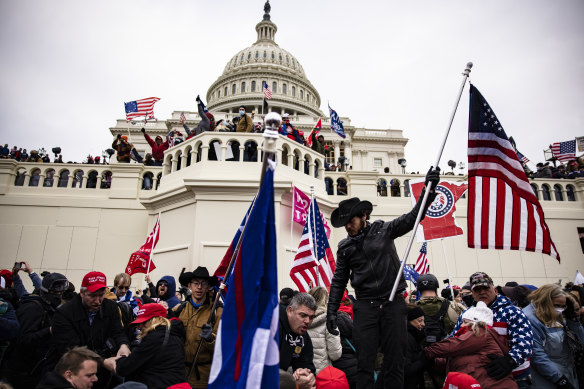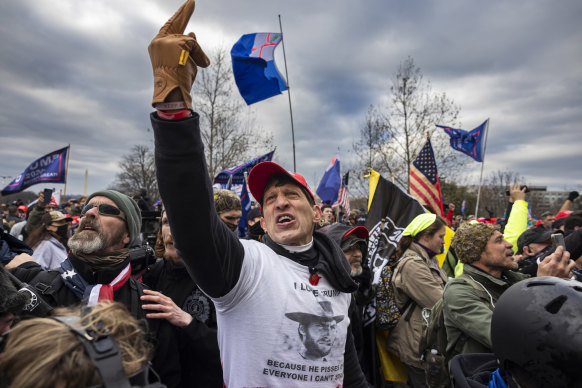Trump’s appetite for upheaval is as American as apple pie
Imagine what the next Trump presidency might look like and scenes of disunity and political violence spring to mind. But that’s no aberration – it’s always been the American way.
By Nick Bryant

Donald Trump’s supporters during the January 6 attack on the US Capitol in 2021. They took his command to “fight like hell” literally.Credit: Getty Images
What would it look like the second time around? The Donald Trump restoration. The former president has a habit of semaphoring his intentions, so anticipating what Trump 2.0 might look like hardly requires a great leap of imagination. We can build a picture from what he’s already said and done and the tell-all books of officials who served at his side.
Maybe, on January 20, 2025, he would get to stage the mammoth military parade he reportedly wanted ahead of his first inauguration. “Make it look like North Korea,” he told aides as he prepared to enter the White House in 2017, “tanks and choppers”. Perhaps a stealth bomber would fly ominously overhead, as this symbol of United States pre-eminence had done at his Salute to America pageant on July 4, 2019.
Perhaps from that inaugural platform, after barking out the oath of office with the palm of his hand on the God Bless the USA Bible he spruiked during the 2024 campaign for $US59.99 ($90), he would instantly pardon the “J6 hostages”, as he has taken to calling the “unbelievable patriots” who stormed the US Capitol on January 6, 2021. Maybe there would be time to fly the J6 inmate choir to Washington in time for them to perform at one of his inaugural balls. Congresswoman Marjorie Taylor Greene, the Trump devotee and conspiracy theory peddler, could welcome them on stage.
What would Trump say in his second inaugural address? Would America’s 47th president accuse immigrants of “poisoning the blood of our country”, as he did in a rally speech in New Hampshire in December 2023? Would he repeat the claim, made on the America First podcast in March 2024, that any Jewish person who voted Democrat hated their religion? Would he signal that the US would abandon NATO or give a green light to the Russian President Vladimir Putin to advance on Kyiv? What would be the most ringing phrase? A repeat of “American carnage” from his 2017 address, or something even darker and more dystopian?
In evaluating the threat Trump poses to US democracy, what he has already done in office, and what he has already threatened, offers disturbing portents.
Once the ceremonial cannons had been fired, and Trump had been paraded down Pennsylvania Avenue to the White House, what would be his first executive action? How would he flourish his Sharpie felt-tip pen? Perhaps he might pardon himself, an act of self-absolution that would instantly take America into a constitutional grey zone. Almost certainly, he would instruct his new attorney general to drop the federal charges mounted against him by the Department of Justice which, because of his legal team’s delaying tactics, had not gone to trial before election day. He might begin drawing up plans to deport 11 million undocumented migrants, which he’d revealed in an interview with Time magazine — a mass deportation without precedent.
Perhaps, he would invite his MAGA brethren onto the lawns of the White House, as his presidential soulmate Andrew Jackson, another demagogic authoritarian, had done after his victory in the 1828 election. Perhaps, he might address them from the balcony of the White House, thus re-enacting the theatrics of his return home from hospital after recovering from COVID-19 – a puffed-up primetime spectacular that looked like a scene from Benito Mussolini’s Rome.
Protests mounted by his opponents that night would likely be met with an iron fist. Military helicopters might fly again at low altitude over Washington, their downdrafts scattering the crowds, in a repeat of the response to the George Floyd protests in the summer of 2020. Maybe the US commander in chief would stride out with the Pentagon’s top brass, as he had done in the immediate aftermath of what was dubbed “the Battle of Lafayette Square” in the park opposite the White House, when riot police beat a crowd of largely peaceful protesters. Mark Milley, the four-star general who’d participated in this martial show of force, later strongly implied that Trump was a “wannabe dictator”. Many Americans, however, yearned for a strongman as president. Occupants of the White House who displayed signs of frailty or weakness rarely got to serve a second term: Jimmy Carter, George H.W. Bush – and now Joe Biden?
Trump himself had boasted during the 2024 campaign of acting like a dictator on “day one”, but his totalitarian tendencies would surely extend beyond those first 24 hours and maybe even define his four years in office. Then what? Perhaps in 2028, he would attempt to remain in power, violating the constitutional amendment that presidents should serve only two terms. Trump, after all, had suggested in December 2022 that he could terminate the US Constitution, with its checks and balances on presidential power.

A disposition to political violence can be traced back to the American War of Independence.Credit: Getty Images
In evaluating the threat Trump poses to US democracy, what he has already done in office, and what he has already threatened, offers disturbing portents. This is a former president, after all, who reportedly suggested while in office that an alligator moat should be built along the southern border with Mexico, stocked also with snakes. If that failed to act as a deterrent, unauthorised immigrants could be shot in the legs to hamper their advance.
From his first presidential campaign, when he encouraged supporters to “knock the crap” out of protesters who infiltrated his rallies, violence had been central to his grievance-fuelled politics. Between Trump and the MAGA diehards, it served as a bonding mechanism, a marker of cultural affinity. According to his then national security adviser, John Bolton, he said that journalists who didn’t reveal sources should not merely be imprisoned but eliminated. “These people should be executed,” Trump said at a meeting in July 2019, “they are scumbags.” When protesters gathered outside the White House at the height of the George Floyd protests in 2020, he asked Milley, then the US’s highest-ranking military officer: “Can’t you just shoot them?” When his lawyers appeared before the Supreme Court in April this year to argue that he should not face criminal prosecution, one of the theories they aired was that a president should enjoy complete immunity even if they ordered hits against political opponents.
Those who think the threat Trump poses to democracy is overblown could not have been watching on January 6, 2021, when his supporters took his commands to march on the Capitol and to “fight like hell” both seriously and literally. Or perhaps they have simply banished the memory of Trump’s militia ransacking Congress. But, then, misremembering the past is as American as apple pie.
When, towards the end of the 1960s – a decade that had witnessed the assassinations of John F. Kennedy, Malcolm X, Martin Luther King jnr and Robert Kennedy – then-president Lyndon Johnson asked a panel of scholars to investigate why there was so much political violence in America, they highlighted the problem of “historical amnesia”. All countries were guilty of a “selective recollection that masks unpleasant traumas of the past”, their report concluded, adding, “but Americans have probably magnified this process of selective recollection, owing to a historic vision of ourselves as a latter-day chosen people, a new Jerusalem”. In other words, a positive sense of American exceptionalism blinded it to its negative aspects, in this instance a disposition towards violence that could be traced back to the War of Independence and the revolutionary credo that political violence was glorious.
What I have set out to do in my new book, The Forever War: America’s Unending Conflict with Itself (Viking, out June 4), is to shine more of a light on the darker aspects of US history that many Americans would rather forget: the very episodes that make sense both of the rise of Trump and the strong possibility that he could win November’s presidential election. For Trump is not some temporary aberration. Though he is often still portrayed as a freak of history, he is as much a product of his country’s past as Franklin Delano Roosevelt, John F. Kennedy, Ronald Reagan and Barack Obama. That troubling thought might challenge our historical belief system about America, but so much of our understanding is based on false narratives, self-validating folklore and fake history.
The January 6 insurrection showed how political violence is still seen as legitimate and even rendered heroic.
Take democracy itself. Even now, America likes to think of itself as a global exemplar, a shining city upon a hill. However, it was not until the mid-1960s that the country achieved universal suffrage. The long-overdue passage of the 1965 Voting Rights Act meant that blacks in the American south could finally cast ballots unhindered and no longer be subjected to humiliating “literacy tests” where they would be asked unanswerable questions such as how many bubbles were in a bar of soap. No sooner had this landmark legislation become law, moreover, than efforts to subvert it started.
So began what has turned out to be a decades-long campaign of de-democratisation, targeted in the main at people of colour and driven by a Republican Party aided and abetted to an alarming degree by what has been, since the turn of the century, the conservative-dominated Supreme Court. January 6, 2021, marked the culmination of that prolonged undermining of democracy. And even after the insurrectionists had been dispersed, the attack continued when almost 150 Republicans returned to the chambers hours later to challenge Biden’s victory.
The January 6 insurrection showed how political violence is still seen as legitimate and even rendered heroic. Ahead of time, Greene described Trump’s Stop the Steal rally as “our 1776 moment”. Modern-day militias are motivated by the words of America’s third president, Thomas Jefferson: “The tree of liberty must be refreshed from time to time with the blood of patriots and tyrants.” Those words have become a far-right meme.
Americans often forget that the defeat of the British brought independence but not automatic nationhood. In its aftermath, George Washington fretted that the former colonies might become several different confederacies rather than a singular United States of America. So the country’s chronic polarisation is nothing new. Disunion has always been the default. The 2024 election, Trump versus Biden, is but the latest battle of what feels like a 250-year forever war: America’s unending conflict with itself.
To read more from Good Weekend magazine, visit our page at The Sydney Morning Herald, The Age and Brisbane Times.